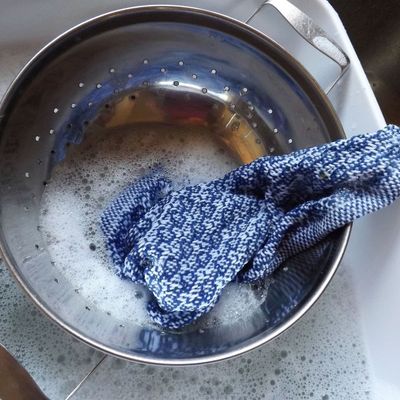
As someone who lives in an apartment without a dishwasher, handwashing dishes has long occupied a not-insignificant portion of my day. And never more than lately, while sheltering in place. No matter how many meals I eat plateless, directly over the sink, the number of dishes that need washing has multiplied threefold. Only one thing has lightened the load: switching from sponges to dishcloths.
I have never been immune to the allure of an overpromising sponge, from the Dobie pad (not usable on nonstick surfaces) to the Scrub Daddy (his smile was never as useful as purported) to the blue Scotch Brite (fine, but part plastic). Longing for an eco-friendly alternative, I tried Trader Joe’s compostable sponges (too soft to properly remove food from dishes). The chief problem with sponges, no matter their construction, is that they all die young.
It was early during quarantine, drowning in my daily heaps of dirty dishes, that I resolved to take the plunge into dishcloths. I was aware of dishcloths — I’d tried the odd one in a hippie’s kitchen here and there, usually a dull cream color, like a crocheted bikini torn directly from a Coachella attendee. But I’d never purchased one myself. I turned to Etsy, where I found Unity Weaver, aka Lu Cook, a weaver based in Unity, New Hampshire. My dishcloth, a single 11-inch square of handwoven cotton, arrived quickly. Immediately and excitedly, I donned my Mommy Hands gloves and got started on a sink full of dirty dishes. The experience was, at first, disorienting and a little bit discouraging. The cloth was so much bigger and floppier than a sponge! My gloved hands found it difficult to grasp the cloth itself. And I couldn’t tell if dishes were getting clean.
It wasn’t long, though, before I landed on a dishcloth technique that worked better than any sponge-wash ever had: Gloveless, I dip the cloth into sudsy water and rub it over each dish, letting its gentle bumpy texture remove stuck food. Then, I put on my dishwashing gloves, turn the water to scalding hot, and rinse the dishes clean. Finally, I wash the dishcloth with hot water, wring it out, and leave it to hang dry, which it does quickly and miraculously.
Dishcloths provide innumerable advantages over sponges — particularly their shape. A cloth can be bunched up to fit inside glasses. Or it can be spread to cover the curves of a bigger pot or bowl. Finding the perfect configuration (bunched, folded, splayed) is part of the dishcloth user’s delight. And once washed and dried, dishcloths are good as new — to be reused ad infinitum. As far as quarantine activities go, you could do worse than to swap your disposable sponges for dishcloths. According to Unity Weaver’s Etsy page, weaving the dishcloths has been Lu Cook’s way of staying occupied. Writes Cook: “During this corona epidemic I plan to continue weaving dishcloths, keep the price affordable and update available colors when they are ready to ship. Keep safe my friends!”
Not ready to spend $16 on a dishcloth and support an artisanal weaver? These gateway dishcloths aren’t bad and are three for $10.
The Strategist is designed to surface the most useful, expert recommendations for things to buy across the vast e-commerce landscape. Some of our latest conquests include the best acne treatments, rolling luggage, pillows for side sleepers, natural anxiety remedies, and bath towels. We update links when possible, but note that deals can expire and all prices are subject to change.







